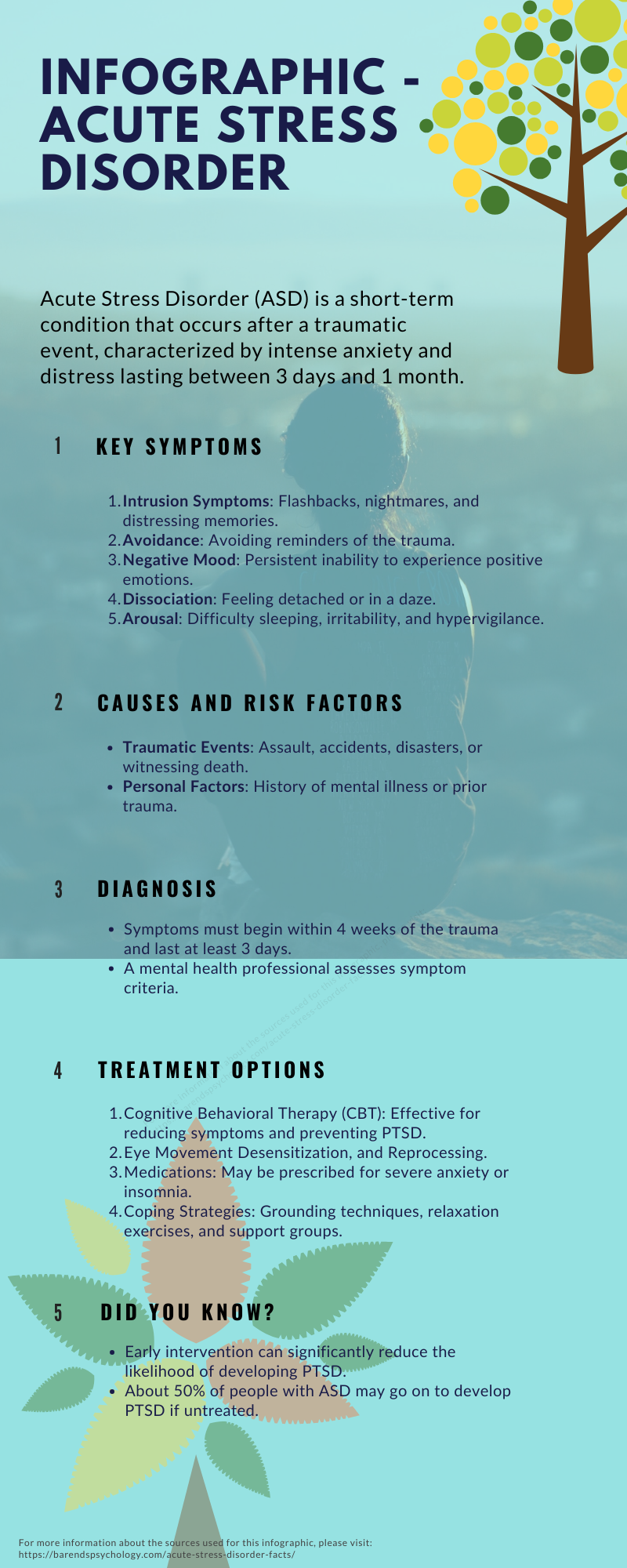Acute stress disorder treatment options.
Despite the fact that acute stress disorder (ASD) cannot persist for longer than a month, treating ASD is crucial for reducing symptoms [2],[3],[4],[6], improving quality of life [5], and preventing the development of post-traumatic stress disorder (PTSD) [2],[3]. Unfortunately, not all treatment options for ASD are effective. For example, medication has proven ineffective in treating ASD [7],[8], and psychoanalysis has failed to demonstrate efficacy in treating ASD for decades.
This article discusses common and effective treatment options for acute stress disorder and explains how they work. The article is updated regularly to ensure accuracy.
Go to:
- Acute stress disorder.
- What causes ASD?
- Diagnosing ASD.
- How to cope with ASD.
- Helping your partner with ASD.
- Take the ASD test.
- ASD facts.
- Online counseling for ASD.
- Take me to the homepage.
At Barends Psychology Practice acute stress disorder treatment is offered (also online). Go to contact us to schedule your first, free session.
Effective Treatment Options for Acute Stress Disorder: Psychotherapy
Acute stress disorder (ASD), also known as shock, is a common response to experiencing traumatic events. Approximately one in five people develop ASD after a traumatic experience [9]. ASD symptoms can make it difficult for individuals to enjoy life, perform at work, or engage in daily activities.
Psychotherapy focuses on reducing ASD symptoms and building coping mechanisms to manage the distress associated with the disorder. Research suggests that early psychotherapy following a traumatic event significantly improves the quality of life for adolescent trauma survivors [5].
Therapeutic approaches like Cognitive Behavioral Therapy (CBT), CBT-hypnosis, and exposure in vivo have been shown to significantly reduce post-traumatic stress symptoms [1],[3]. Early trauma-focused cognitive behavioral therapy (TFCBT) not only treats ASD effectively but can also prevent the development of complex PTSD in individuals diagnosed with ASD [2]. Similarly, Eye Movement Desensitization and Reprocessing (EMDR) has proven as effective as CBT and exposure in vivo in treating ASD [3],[4].
Comparison of Therapies
-
Exposure in vivo
This therapy involves controlled (and often gradual) exposure to feared objects, thoughts, or situations. People with ASD may subconsciously avoid reminders of the traumatic event, but this avoidance prevents proper processing of the trauma. Through exposure in vivo, patients learn that these reminders, thoughts, and memories are not dangerous. This leads to a significant reduction—or even disappearance—of ASD symptoms.
-
EMDR
EMDR helps process distressing memories and beliefs by using bilateral stimulation while the patient recalls the traumatic event in their imagination. Research shows that EMDR facilitates proper processing of these memories, neutralizing the negative emotions and beliefs attached to them, which significantly reduces ASD symptoms.
-
CBT
CBT focuses on developing personal coping strategies to address current problems and change unhelpful patterns in thoughts, beliefs, attitudes, behaviors, and emotional regulation. Patients learn to confront ASD-related thoughts, feelings, and memories instead of avoiding them, resulting in symptom reduction.
-
CBT-hypnosis
A combination of CBT and hypnosis, this approach may lead to deep relaxation, uncover deeper underlying beliefs and attitudes, and enhance imagery, improving outcomes for ASD patients.
-
SWT
Similar to TFCBT, SWT involves writing exercises to process trauma. While more research is needed, initial findings are promising regarding its effectiveness.
(Advertisement: For more information about ASD treatment, please scroll down.)
Effective Treatment Options for Acute Stress Disorder: Medication
Medication is not recommended as a first-line treatment for ASD, as it does not significantly reduce acute stress disorder symptoms [7],[8]. Two meta-analysis studies found no significant effect of pharmaceutical drugs on ASD symptom reduction [7],[8].
However, if ASD develops into PTSD, medication—specifically selective serotonin reuptake inhibitors (SSRIs)—can help alleviate PTSD symptoms, including re-experiencing, avoidance/numbing, and hyperarousal, as categorized in the DSM-IV [7],[8].
Literature
- [1] Bryant, R. A., Moulds, M. L., Guthrie, R. M., & Nixon, R. D. (2005). The additive benefit of hypnosis and cognitive-behavioral therapy in treating acute stress disorder. Journal of Consulting and Clinical Psychology, 73, 334.
- [2] Kornør, H., Winje, D., Ekeberg, Ø., Weisæth, L., Kirkehei, I., Johansen, K., & Steiro, A. (2008). Early trauma-focused cognitive-behavioural therapy to prevent chronic post-traumatic stress disorder and related symptoms: a systematic review and meta-analysis. BMC psychiatry, 8, 81.
- [3] Ponniah, K., & Hollon, S. D. (2009). Empirically supported psychological treatments for adult acute stress disorder and posttraumatic stress disorder: a review. Depression and anxiety, 26, 1086-1109.
- [4] Forbes, D., Creamer, M., Phelps, A., Bryant, R., McFarlane, A., Devilly, G. J., … & Newton, S. (2007). Australian guidelines for the treatment of adults with acute stress disorder and post-traumatic stress disorder. Australian & New Zealand Journal of Psychiatry, 41, 637-648.
- [5] Holbrook, T. L., Hoyt, D. B., Coimbra, R., Potenza, B., Sise, M., & Anderson, J. P. (2005). High rates of acute stress disorder impact quality-of-life outcomes in injured adolescents: mechanism and gender predict acute stress disorder risk. Journal of Trauma and Acute Care Surgery, 59, 1126-1130.
- [6] Van Emmerik, A. A., Kamphuis, J. H., & Emmelkamp, P. M. (2008). Treating acute stress disorder and posttraumatic stress disorder with cognitive behavioral therapy or structured writing therapy: A randomized controlled trial. Psychotherapy and psychosomatics, 77, 93-100.
- [7] Ursano, R. J., Bell, C., Eth, S., Friedman, M., Norwood, A., Pfefferbaum, B., … & Charles, S. C. (2004). Practice guideline for the treatment of patients with acute stress disorder and posttraumatic stress disorder. Am J Psychiatry, 161(11 Suppl), 3-31.
- [8] Davidson, J. R. (2006). Pharmacologic treatment of acute and chronic stress following trauma: 2006. J Clin Psychiatry, 67(Suppl 2), 34-9.
- [9] Holeva, V., Tarrier, N., & Wells, A. (2001). Prevalence and predictors of acute stress disorder and PTSD following road traffic accidents: Thought control strategies and social support. Behavior Therapy, 32, 65-83.


